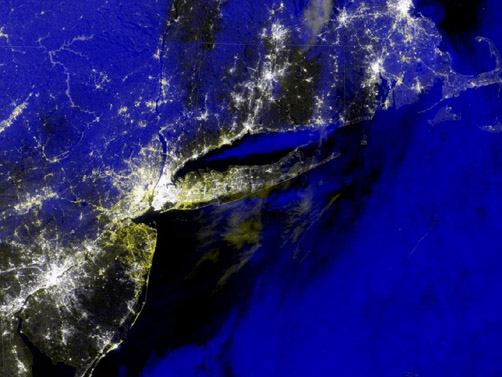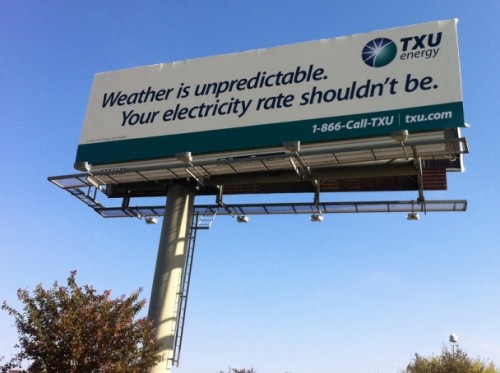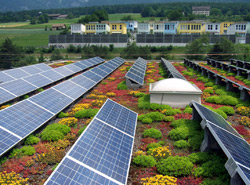by Bob Henson, AMS Councilor and Chair, AMS Committee on Environmental Stewardship (ACES)
Those of us involved with climate change in our professional lives—researchers, educators, authors, students—often feel the need to “walk the walk” in a demonstrable way. AMS is one of the world’s premier organizations involved with peer-reviewed research on our changing atmosphere, so it’s only fitting that the Society is finding ways to demonstrate its environmental bona fides in its own operations. For example, AMS has been a leader this past decade in working toward “green meetings.” An upcoming BAMS article will feature some green-meeting highlights, and a summary can also be found in the “About AMS” section of the AMS website.
Just in time for the Society’s 100th birthday, AMS has now ensured that the electricity supply in its offices in Boston and Washington, D.C., is effectively 100% renewable. The Boston shift involved working with the nonprofit Green Energy Consumers Alliance (GECA), a spinoff of Massachusetts Energy that works to maximize the use of renewables in the state’s electricity supply.
AMS recently finalized a renewable two-year agreement (retroactive to January 2019) to purchase Class I renewable energy certificates (RECs) from GECA. These certificates are equal to the full amount of electricity consumed at the AMS buildings at 44 and 45 Beacon Street. Each certificate mandates the production of one megawatt hour of renewable energy, documenting where, how, and when the energy (in this case, wind energy) was produced. In 2019, energy providers in Massachusetts were required to purchase in-state Class I RECs for 14% of all electricity they generate, a percentage that goes up each year by 1%. When entities such as AMS also purchase Massachusetts Class I RECs, it further stimulates the market for clean energy. In other words, Massachusetts Class I RECs don’t simply buy green energy that is already government-mandated; they actually promote the creation of new green-energy supplies within the state.
AMS Controller Joe Boyd worked with the AMS Committee on Environmental Stewardship (ACES) to research options for renewable energy at the Boston building and shepherded the final agreement with GECA.
“Given the Society’s strong commitment to environmental issues, it was natural that we include 100% renewable electricity sourcing to our efforts to maintain a small carbon footprint,” says AMS Executive Director Keith Seitter.
In Washington, AMS leases office space within the headquarters of the American Association for the Advancement of Science at 1200 New York Avenue NW. This building’s electrical supply is also effectively 100% renewable, via RECs that are purchased through a Constellation New Energy contract for transmission and generation. (The RECs do not include electric distribution, and the building also uses a small amount of natural gas.)
“ACES continuously strives to promote the Society’s environmentally progressive standards, complementing the research and efforts of AMS members. Thanks to felicitous timing, the Society is celebrating its transition to 100% renewable energy on its 100th anniversary,” says incoming 2020 ACES Chair C. Todd Rhodes (Coastal Carolina University).
energy
Annual Meeting Session to Feature Solar Energy Contest Winners
The AMS Solar Energy Prediction Contest brought together participants from around the world to tackle the problem of improving solar energy forecasting. The contest was held on Kaggle , a website for hosting worldwide data mining and machine learning contests. Participants used a set of NOAA Global Ensemble Forecast System reforecasts as input for statistical and machine learning models that predicted the total daily solar energy at 98 Oklahoma Mesonet sites. Over the four-month span of the contest, 157 teams from six continents submitted over 2,500 sets of predictions. The winners were:
First Place:
Lucas Eustaquio Gomes da Silva (Belo Horizonte, Brazil) and
Gilberto Titericz Jr. (São José dos Campos, Brazil)
Second Place:
Benjamin Lazorthes (Toulouse, France)
Third Place:
Owen Zhang (New York, New York)
Top Student Winner:
Gilles Louppe (Liège, Belgium)
The first-place, second-place, and student winners will present their methods at a special session (Wednesday, February 5, 1:30-2:30 p.m., Room C204) of the AMS Annual Meeting. Specialists in renewable energy and data science as well as all interested attendees are invited to learn about the methods used in the contest and to discuss what value the contest results may provide for forecasts of renewable energy and other phenomena.
The contest is jointly sponsored by the 12th Conference on Artificial and Computational Intelligence and its Applications to the Environmental Sciences; the 22nd Conference on Probability and Statistics in the Atmospheric Sciences; and the Fifth Conference on Weather, Climate, and the New Energy Economy.
You can find more information about the contest here. The winners’ model approaches and codes are available here.
Give Solar Energy a Boost–and Win a Prize
A Conversation with T. Boone Pickens: Tonight Is about Opportunities
Often, when people talk about T. Boone Pickens–the featured guest at the AMS Annual Meeting special session at 7:30 p.m. tonight (Ballroom D)–they remind you that he got his start as a paper boy. At age 12, Pickens took a newspaper route with 28 deliveries and turned it, through merger and acquisition, into a conglomerate of 156. A penchant for rapid expansion through acquisition was born, and the result was an investor-corporate dynamo.
But we’re AMS, so we’re not here to talk about how he made his billions with Mesa Petroleum or BP Capital Management. Tonight AMS Policy Director William Hooke will undoubtedly ask Pickens how he intends to make his next billion, and–from everything Pickens is saying–he’s going to do it by taking advantage of what science is telling him.
In that regard, Pickens is clearly not the common businessman. He explains, “The gambling instincts I inherited from my father were matched by my mother’s gift for analysis.”
So, instead of paper routes and corporate raiding, we’re going to remind you that T. Boone Pickens got his start in the oil business with a Bachelor’s Degree in geology. Indeed, while Pickens is the kind of businessman who takes opportunities where he sees them, usually that means seeing the big processes, the glacial but inevitable trends and not just the ephemera blowing in the wind. Actually, he also lost $150 million on wind energy already–abandoning one-time plans to build the world’s largest wind farm in Texas–and so in that sense no one is better qualified than Pickens to kick off the intensive discussions this week about how our science is working to make renewable energy a better bet these days.
Right now, the big picture is telling Pickens that natural gas is the alternative fuel of choice, as a means of ending American dependence on imported energy resources.
As ever, energy is, for Pickens, an opportunity, but it’s also about the big picture–really the biggest picture of where society is heading economically, strategically, politically, socially, geophysically. For us, then, the strategic move is to capitalize not on what science has to tell business, but on what business has to tell science, tonight, in Ballroom D.
Versatile VIIRS: Sandy Reveals More of Its Potential
The VIIRS instrument aboard the new Suomi National Polar-orbiting Partnership (NPP) satellite has a lot of jobs: among them, to measure cloud and aerosol properties, ocean color, sea and land surface temperature, ice motion and temperature, fires, and Earth’s albedo. Now, with the experience of Superstorm Sandy behind it, add tracking power blackouts to the list of tasks for this multifaceted instrument.
VIIRS–or more formally, Visible Infrared Imager Radiometer Suite, is a scanning radiometer that collects visible and infrared imagery and radiometric measurements of the land, atmosphere, cryosphere, and oceans. Its low-light sensor–known as the day-night band–can detect light from cities and towns in the absence of clouds. This function recently proved to be highly valuable when NASA’s Short-term Prediction Research and Transition Center used data from VIIRS to assist disaster responses agencies (including FEMA and the U.S. Army Corps of Engineers) in identifying areas that lost power during Superstorm Sandy. Composites of VIIRS images taken before and after Sandy (see below for an example) pinpointed the blackouts.
This is just one example of the promising capabilities of VIIRS; and the growing awareness of these capabilities is why VIIRS is the subject of a town hall meeting on Monday, January 7 (12:15-1:15 p.m., Room 18B) at the AMS Annual Meeting in Austin. Forecasters, meteorologists, and other end users will discuss how they are utilizing the new VIIRS datastream and the critical role it can play in weather forecasting and in improving emergency preparedness and disaster response efforts.
A number of other presentations in Austin will highlight the versatility VIIRS. Jeffrey Hawkins of the Naval Research Laboratory will take an in-depth look at VIIRS’s day-night band and efforts to create enhanced products geared toward various nowcasting applications (e.g., dust enhancement observations, smoke and volcanic ash plumes, cloud properties, tropical cyclone structure, etc.) (Wednesday, 1:30 p.m., Ballroom G). Donald Hillger of NOAA/NESDIS will compare and contrast imagery produced by VIIRS with that from other satellites (Tuesday, 11:45 a.m., Ballroom G). And Jim Biard of the Cooperative Institute for Climate and Satellites will provide details on the VIIRS Climate Raw Data Record (C-RDR), including its contents and structure, its production methods and process, and file access (Wednesday, 11:30 a.m., Ballroom G).
VIIRS is one of five instrument/sensor payloads aboard Suomi-NPP, which is the first of a new breed of satellites that will replace NASA’s Earth Observing System satellites. Launched in October of 2011, the progress and promise of Suomi-NPP and its new data applications will be explored at a town hall meeting on Tuesday (12:15-1:15 p.m.; Ballroom G).
Speaking of Superstorm Sandy, electricity outages, and town hall meetings, there are two related Town Halls of special importance Monday night at the AMS meeting: a wide-ranging meeting on the storm itself (7:30-9:30 p.m.; Ballroom E) and an exploration of the impacts of weather on the electrical grid (Monday, 6:30-8:00 p.m.; Room 14). More on this in future posts on The Front Page.

Roadside Detraction
 Broadcast meteorologist Kevin Selle posted this picture to his blog, Digital Meteorologist, with the spot-on comment: “Note to self. Switch energy providers.”
Broadcast meteorologist Kevin Selle posted this picture to his blog, Digital Meteorologist, with the spot-on comment: “Note to self. Switch energy providers.”
Consider these events from the upcoming AMS Annual Meeting:
- What Do Meteorologists Need to Know about the Energy Sector–and Vice Versa–to Integrate Weather-Driven Renewables into the Electric Grid (Monday 24 January, 7 p.m., Town Hall meeting)
- Dollars and Cents: Weather for Energy Markets and Weather Fundamentals for Energy Planning (Thursday 27 January sessions of the Conference on Weather Climate and the New Energy Economy).
Meanwhile the atmospheric science community moves on, working to make lives easier and more stable for utilities and their customers. For instance, Erica Zell will be presenting “NASA Products to Enhance Energy Utility Load Forecasting” (Wednesday, 26 January) in Seattle. She notes:
Existing load forecasting tools rely upon historical load and weather, and forecasted weather to predict load within energy utility service areas. Microclimates and weather events such as stalled fronts have proved particularly challenging for load forecasting. The shortcomings of load forecasts are often the result of weather data that is not at a fine enough spatial resolution to capture local-scale weather events.
Zell offers hope by integrating high resolution satellite-derived atmospheric information into load forecast tools.
We could go on, of course.
Energy provider driving down Texas highway mutters: “Note to self. Switch energy providers!”
Cool Roofs Seen in Black, White, and Green
Science teaches us not to answer questions in black and white terms—the meaning of data usually has many shades of gray. So it is with figuring out the micro and macro effects that different roof coverings might have on global warming or energy efficiency. The answers are starting to look more complex, and more promising, than ever.

For example, it would seem natural when studying rooftops and their effects on climate large and small to focus on extremes of albedo—in other words, black and white surfaces. This is sometimes the case in simplified modeling studies. But at this week’s AMS 9th Symposium on Urban Environment, in Keystone, Colorado, Adam Scherba of Portland State University submitted findings that moved beyond simple comparisons of white (“cool”) roofs versus black roof coverings. He and his colleagues mixed roof coverings, notably photovoltaic panels and greenery (which has the advantage of staying cooler during the day but not, like white roofs, getting much colder at night). The mix makes sense when you consider that roofs are also prime territory for harvesting solar energy. Scherba et al. write that
While addition of photovoltaic panels above a roof provides an obvious energy generation benefit, it is important to note that such systems – whether integrated into the building envelope, or mounted above the roof – can also result in an increase of convective heat flux into the urban environment. Our analysis shows that integration of green roofs with photovoltaic panels can partially offset this undesirable side effect, while producing additional benefits.
This neither-black-nor-white-nor-all-green approach to dealing with surface radiation makes sense from both energy and climate warming perspectives, especially given the low sun angles, cold nights, and snow cover in some climates. For instance, a recent paper, in Environmental Research Letters, uses global atmospheric modeling to estimate that boosting albedo by only 0.25 on roofs worldwide—in other words, not a fully “cool” scenario of all white (albedo: 1.0) roofs—can offset about a year’s worth of global carbon emissions.
And the authors of a recent modeling study (combining global and urban canyon simulation) published in Geophysical Research Letters simulated a world with all-white roofs but showed that:
Global space heating increased more than air conditioning decreased, suggesting that end-use energy costs must be considered in evaluating the benefits of white roofs.
Delving directly into such costs this week at the AMS meeting is a paper from a team led by Anthony Dominguez of the University of California-San Diego. They looked at the effects of photovoltaic panels on the energy needs in the structure below the roof, not the atmosphere above it.
Did they find that a building is easier to keep comfortable when covered by solar panels? Well, if you need to air-condition during the day, yes. If, however, like many people on the East Coast this summer, you need to keep cooling at night, then no. This is science—don’t expect a black-and-white answer.